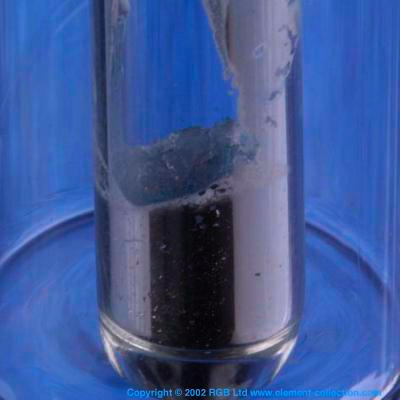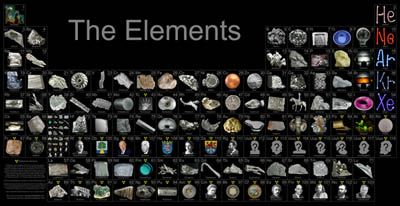|
|
|
|
|
|
|
|
|
|
|
|
|
|
|
|
As you go down the left-most column of elements in the periodic table, they become progressively more reactive. Lithium bubbles slowly in water, sodium bubbles faster and usually explodes, potassium definitely explodes. By the time you get to rubidium, its to the point where even the moisture in the air can be enough to set it off. Rubidium also has a very low melting point, so if it gets going it quickly turns into a liquid, greatly increasing the rate of reaction. For this reason rubidium must be kept in sealed glass ampules or under an inert gas atmosphere.
There are not a lot of industrial uses for rubidium, but one of them is as a time standard. Electronic transitions in the atoms in a rubidium vapor are used as a very, very stable frequency reference: You can buy such modules for less than a hundred dollars on eBay, for example (see below for a sample of one). Cesium is also used for this purpose, but cesium time standards are much more expensive.
|
|
| |
|
|
|
|
|
Sealed ampule.
Rubidium is much like cesium in that it's a solid at room temperature, but liquid just a bit higher. Cesium actually melts in your hand, while rubidium needs to be just a bit warmer. Cesium also has a much prettier color, exactly the color of gold.
They would both, however, explode on contact with moist air, so we keep them both safely locked up.
Click the source link for an interesting story about where this sample came from.
Source: Tryggvi Emilsson and Timothy Brumleve
Contributor: Tryggvi Emilsson and Timothy Brumleve
Acquired: 6 September, 2002
Price: Donated
Size: 2.5"
Purity: 99.9%
|
|
|
|
|
|
|
Sample from the RGB Set.
The Red Green and Blue company in England sells a very nice element collection in several versions. Max Whitby, the director of the company, very kindly donated a complete set to the periodic table table.
To learn more about the set you can visit my page about element collecting for a general description or the company's website which includes many photographs and pricing details. I have two photographs of each sample from the set: One taken by me and one from the company. You can see photographs of all the samples displayed in a periodic table format: my pictures or their pictures. Or you can see both side-by-side with bigger pictures in numerical order.
The picture on the left was taken by me. Here is the company's version (there is some variation between sets, so the pictures sometimes show different variations of the samples):

Source: Max Whitby of RGB
Contributor: Max Whitby of RGB
Acquired: 25 January, 2003
Text Updated: 11 August, 2007
Price: Donated
Size: 0.2"
Purity: 99%
|
|
|
|
|
|
|
Sample from the Everest Set.
Up until the early 1990's a company in Russia sold a periodic table collection with element samples. At some point their American distributor sold off the remaining stock to a man who is now selling them on eBay. The samples (except gases) weigh about 0.25 grams each, and the whole set comes in a very nice wooden box with a printed periodic table in the lid.
To learn more about the set you can visit my page about element collecting for a general description and information about how to buy one, or you can see photographs of all the samples from the set displayed on my website in a periodic table layout or with bigger pictures in numerical order.
Source: Rob Accurso
Contributor: Rob Accurso
Acquired: 7 February, 2003
Text Updated: 29 January, 2009
Price: Donated
Size: 0.2"
Purity: >99%
|
|
|
|
|
|
|
  Time standard cell. Time standard cell.
Rubidium and cesium, which are in the same column of the periodic table and share many of the same chemical properties, are also both used as very high accuracy time standards. A collection of cesium clocks is the current international standard for time. Rubidium clocks are not as accurate, but they are a whole lot cheaper: Functional units can be had for just a hundred dollars or so on eBay.
This is the smallest currently available rubidium cell from inside such a time standard. You can just barely see the drop of rubidium inside the square glass cell (which is only about 1/4" on edge, to give you an idea of how small this thing is). The picture is focused such that the rubidium dot is in focus on the back face of the cell: See the 3D version to get a better view of the unit as a whole. In operation the cylinder next to the cell heats up (you can see the electrical contacts on the back in the 3D view) to the point where the rubidium is vaporized, the coils wrapped around the unit as a whole sets up a magnetic field, and it is the frequency of an electronic transition of the vaporized rubidium atoms in this field that is used as the time standard.
Source: eBay seller pablof_azul
Contributor: Theodore Gray
Acquired: 20 June, 2003
Price: $30
Size: 1"
Purity: >99%
|
|
|
|
|
|
|
  Ampule. Ampule.
This is a lovely sealed ampule containing one gram of rubidium metal. I have used my hot photographic light to partially melt the contents (which was foolish and dangerous of course). There's just something fascinating about a liquid metal! This one forms a nice mirror on the surface of the ampule if you shake it. It makes a very nice set together with the very similar cesium ampulealso from David Franco.
I chose this sample to represent its element in my Photographic Periodic Table Poster. The sample photograph includes text exactly as it appears in the poster, which you are encouraged to buy a copy of.

Source: David Franco
Contributor: David Franco
Acquired: 10 July, 2003
Text Updated: 4 May, 2007
Price: Donated
Size: 0.5"
Purity: 99.9%
|
|
|
|
|
|
|
  Rubidium time standard. Rubidium time standard.
I feel a bit guilty about this sample. It started as a perfectly good, said to be entirely functional, Efratom FRS 10MHz time standard, which I ruthlessly tore apart to get to the glass ampule you see here, which contains a tiny amount of rubidium. It will never tell time again. In operation heating coils would have raised the temperature of the ampule enough to vaporize the rubidium. Radio frequency coils then excite the rubidium atoms and measure the frequency of their electronic transitions, which are very stable. (Cesium atomic clocks work on the same principle and are even more accurate, but for some reason rubidium ones are cheaper.)
I've left as much circuitry as I could on the ampule. This module was completely enclosed in circuit boards on four sides, and the whole assembly was built into a metal can.
Source: eBay seller nhbbobb1985
Contributor: Theodore Gray
Acquired: 19 November, 2008
Text Updated: 29 January, 2009
Price: $38
Size: 2"
Purity: 99.9%
|
|
|
|
|
|
|
|
|
|
  Rubidium time standard exciter. Rubidium time standard exciter.
This is a small bulb that, in the original device, was positioned next the cell shown in the previous sample. It is, I am told, filled with a larger amount of rubidium than the larger cell, and serves as the the exciter, transmitting radio waves of the correct frequency to excite the lower-pressure rubidium vapor in the larger cell. (Lower pressure means narrower spectral line, and thus higher accuracy.)
Source: eBay seller nhbbobb1985
Contributor: Theodore Gray
Acquired: 19 November, 2008
Text Updated: 10 January, 2009
Price: $38
Size: 0.75"
Purity: 99.9%
|
|
|
|
|
|
|
  RbMnF3 crystal. RbMnF3 crystal.
I don't even know what you'd call this other than by its chemical name: It's a pretty pinkish little bar of what is probably a single crystal, crudely cut and roughly surfaced, but not polished to any significant degree. It came from a batch of old samples and research materials being discarded by Ethan's university. The fact that it's translucent and colored makes me think it might be intended as some kind of laser material, whether it worked or not I have no idea. The fact that they threw it away may or may not indicate something about its usefulness.
Source: Ethan Currens
Contributor: Ethan Currens
Acquired: 16 March, 2007
Text Updated: 14 October, 2008
Price: Donated
Size: 1"
Composition: RbMnF3
|
|
|
|
|
|
|
  Londonite-Rhodizite. Londonite-Rhodizite.
Description from the source:
Londonite-Rhodizite serie ( (Cs K Rb) Al4 Be4 (B Be)12 028 to Rb=0 for the pure Rhodizite cub.), Antandrokomby, Antsirabe`, Madagascar. Rich in rubidium example, with Tourmaline (probably Liddicoatite). 3,1x2,5x2 cm; 22 g.
Source: Simone Citon
Contributor: John Gray
Acquired: 30 September, 2008
Text Updated: 1 October, 2008
Price: Trade
Size: 1.25"
Composition: (CsKRb)Al4Be4(BBe)12028
|
|
|
|
|
|
|
|
|
|
  Londonite-Rhodizite. Londonite-Rhodizite.
Description from the source:
Londonite-Rhodizite serie ( (Cs K Rb) Al4 Be4 (B Be)12 028 to Rb=0 for the pure Rhodizite cub.), Antandrokomby, Antsirabe`, Madagascar. Yellow, partially translucent crystals on matrix with tourmaline. I repeat these species also for other elements, but are very interesting and rich in rare elements. 3,5x2,5x1,5 cm; 12 g.
Source: Simone Citon
Contributor: John Gray
Acquired: 19 November, 2008
Text Updated: 20 November, 2008
Price: Trade
Size: 1.4"
Composition: (CsKRb)Al4Be4(BBe)12
|
|
|
|
|
|
|
  Londonite-Rhodizite. Londonite-Rhodizite.
Description from the source:
Londonite-Rhodizite serie ( (Cs K Rb) Al4 Be4 (B Be)12 028 to Rb=0 for the pure Rhodizite cub.), Antandrokomby, Antsirabe`, Madagascar. Perfect isolated crystals. 1x0,8x0,7 cm the bigger; 2 g all.
Source: Simone Citon
Contributor: John Gray
Acquired: 28 January, 2009
Text Updated: 29 January, 2009
Price: Trade
Size: 0.4"
Composition: (CsKRb)Al4Be4(BBe)12028
|
|
|
|
|
|
|
|
|
|
|
|
|
|
|